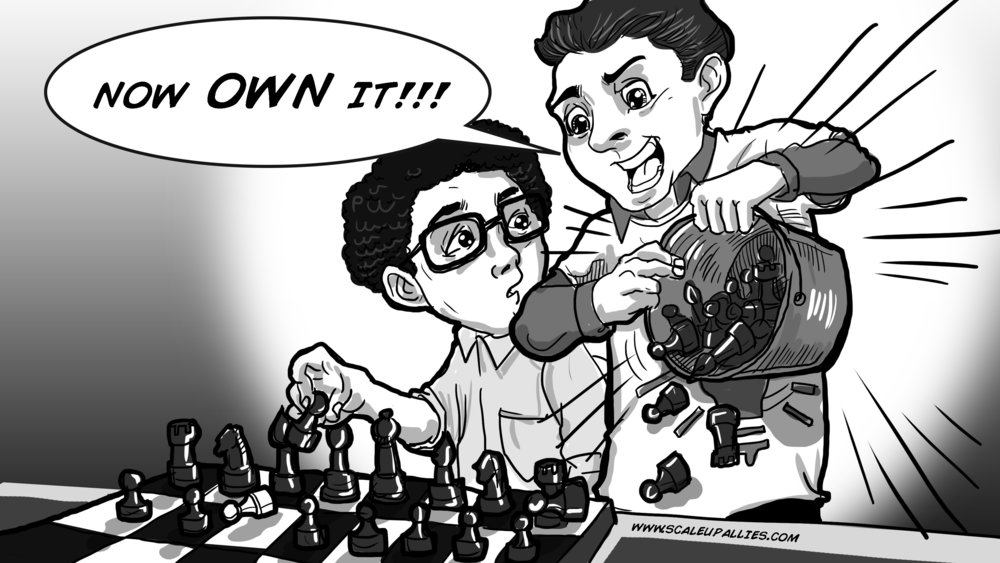The New Tech Scaleup Mission: Reaching Product-Market-Dominance

“Product-Market-Dominance means having an unassailable leadership position in your product-market”
–Roland Siebelink
Doug: Where do founders want to get to, after they have reached product-market-fit?
Roland: Most founders focus on successive funding rounds. They try to keep growing the company all the way to Unicorn status and/or an IPO.
Doug: Making these founders incredibly rich.
Roland: That is what the press would have you believe. And indeed, some of the most successful founders have made billions of dollars. But the press ignores the many founders focused too much on raising ever more capital. So much that they had diluted their holding to almost nothing.
Doug: They would still make a few million bucks on exit.
Roland: Of course, and a few million is nothing to sneer at. My point is that they might have kept more of the company with a different goal in mind. If they had focused on maximizing their market power, rather than capital raised.
Doug: Just like a startup should focus more on the milestone of product-market-fit than on raising seed funding?
Roland: Yes, that is a very good comparison. And the new milestone should be to turn the product-market-fit into product-market-dominance.
Doug: Why product-market-dominance?
Roland: Because it attacks the most common causes of scaleup failure. Let me illustrate with the help of Jason, who identified three common reasons why (funded) startups fail after product-market-fit:
-
“When the market does not show the scale, velocity or depth to sustain initial margins;
-
“When there are too many competitors in the market, competing each other to death;
-
“When founders get emboldened and move to the next thing too early.
Doug: Is there a common theme between these three reasons?
Roland: I think there is. I think it is the failure to turn product-market-fit into product-market-dominance.
With product-market-fit, the startup secures a main foothold in a market. But when can they turn that foothold into unassailable market leadership? So that the company and investors can reap the benefits of the superior offering.
Each of the reasons above represents a failure to reach product-market-dominance in time.
Doug: Can you show us the link between the above reasons and product-market-dominance?
Roland: Of course! Let us take them one by one:
-
Scale reasons: failure to design a business model for the entire market. Beyond early adopters;
-
Competition reasons: failure to protect the unique product-market-fit with barriers to entry;
-
Distraction reasons: failure to stick with the product-market penetration. At least until early majority leadership is within reach.
Setting product-market-dominance as the key goal post product-market-fit is crucial in tech companies. The marginal cost of advanced technology development is low to non-existent. So tech markets converge onto one gorilla that completely dominates the category:
-
Microsoft Office in productivity software;
-
Oracle in enterprise databases;
-
Google in search
-
Facebook in social;
-
Amazon in e-commerce;
-
SalesForce.com in CRM software;
-
Etc., etc., etc.
Doug: You have to become the gorilla in your market.
Roland: That is exactly my point. Once a startup reaches product-market-fit, it shows potential to both investors and competitors. It is crucial to focus all energy and resources on securing market leadership. Otherwise the startup will condemn itself to also-ran status.
In other words, as soon as you reach product-market-fit, the game changes. Startups that adopt the scaleup playbook have a good chance of becoming the gorilla. Those that stick with the startup playbook for too long must fail. Even after reaching product-market-fit.
Doug: I am not sure I have heard this term “product-market-dominance” before. Where does it come from and what does it mean?
Roland: Product-market-dominance means having an unassailable leadership position in your product-market. It means:
-
having the biggest market share in the product-market
-
enjoying majority recognition as the #1 in the product-market
-
having established an impregnable “moat” around your “castle”.
Doug: Why did you introduce a new term?
Roland: I noticed scaleup founders focused too much on product-market-_fit_. So I started using product-market-_dominance_ as a counterweight.
By the mid 2010s, the term product-market-_fit_ was well established. Lean Startup made founders great at iterating through build-measure-learn cycles. Reaching product-market-fit seemed to be all that mattered.
One day, I started noticing a dangerous pattern in my talks with scaleup leaders. As soon as they reached product-market-fit, they started working on a second product. And a third.
Doug: They abandoned the product as soon as it “fit” the market?
Roland: Not quite “abandoned”, more like “left to its own devices”. As if product-market-fit represented the end point of the entrepreneurial journey. As if the milestone of product-market-fit meant a job completed.
Doug: Have they not? I thought all startup literature suggested that product-market-fit is the goal?
Roland: And it is. For the startup phase. But it is not because the business has overcome the startup phase, that its journey has ended. It has simply turned into a different kind of company: a scaleup.
Doug: And rather than for product-market-fit, it should aim for product-market-dominance?
Roland: Exactly! The main job of the scaleup is to reach product-market-dominance. To reach the #1 position in the product-market they have found. Before incumbents can block their ascent.
Roland Siebelink regularly speaks and writes about leadership in fast-growing tech startups. You can find more of his insights, including free chapters of his book “Scaling Silicon Valley Style.”